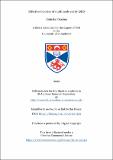Files in this item
Effective theories of multimode cavity QED
Item metadata
| dc.contributor.advisor | Keeling, Jonathan Mark James | |
| dc.contributor.author | Palacino, Roberta | |
| dc.coverage.spatial | 163 | en_US |
| dc.date.accessioned | 2023-03-21T10:45:57Z | |
| dc.date.available | 2023-03-21T10:45:57Z | |
| dc.date.issued | 2022-11-29 | |
| dc.identifier.uri | https://hdl.handle.net/10023/27234 | |
| dc.description.abstract | This thesis focuses on methods for the derivation of effective theories in models describing cold atoms in optical cavities. Among those models, the Dicke model and its generalisations are among the most representative and studied problems in quantum electrodynamics. It describes the coupling of matter in the form of two-level atoms to a quantised mode of light. The Dicke model has been realised in various physical platforms, such as N-V centers in diamond, molecules coupled to an optical mode, trapped ions, as well as in superconducting qubits coupled to microwave resonators. Extensions of the Dicke model have also been widely used in modelling exciton-polariton condensation with organic molecules. Another realisation involves laser-driven atoms coupled to light in a dissipative cavity. This thesis will focus on the latter type of physical system. When the coupling between light and matter reaches a critical point, the Dicke model predicts a phase transition to a superradiant state. Moreover, the onset of the superradiant phase transition coincides with the breaking of the discrete Z₂ symmetry in the model. Motivated by experimental advances in the field, there has been a growing interest in the realisation and analysis of generalised Dicke models such as those with continuous symmetry. In these models, the symmetry breaking phase transition is expected to allow for the observation of Goldstone modes. In order for the cavity QED system to be described by a Dicke model with continuous symmetry, one has to consider multimode extensions of the well characterised single mode experiments. Another extension made possible by multimode cavities is associative memory models, where cavity modes mediate interactions between ensembles of atoms. In many body cavity QED models, the Hilbert space dimension grows according to the number of atoms and modes involved, therefore, solving and fully characterising these problems becomes a challenging task. This is why one has to move to effective descriptions in terms of a reduced number of degrees of freedom. The most widely used technique is Redfield theory, an equation of motion describing the dynamics of the slowest part of the system, after elimination of the fast component. In our atom-cavity picture, the slow and fast components of the total system will be the atoms and the cavity light, respectively. There are cases where Redfield theory is inadequate to accurately capture dynamics and critical behavior. Given the approximations leading to the Redfield equation, this could be considered as the second order of a perturbative expansion in the light-matter coupling. By adopting a diagrammatic method, one could write a Redfield theory beyond its standard second order formula. In this thesis, these techniques will be employed to analyse a two-mode Dicke model with U(1) symmetry and a model of associative memory. | en_US |
| dc.language.iso | en | en_US |
| dc.rights | Creative Commons Attribution-NonCommercial-NoDerivatives 4.0 International | * |
| dc.rights.uri | http://creativecommons.org/licenses/by-nc-nd/4.0/ | * |
| dc.subject | Dicke model | en_US |
| dc.subject | Superradiance | en_US |
| dc.subject | Multimode cavity-QED | en_US |
| dc.subject | Redfield theory | en_US |
| dc.subject | Keldysh diagrams | en_US |
| dc.subject | Spectral theory of Liouvillians | en_US |
| dc.title | Effective theories of multimode cavity QED | en_US |
| dc.type | Thesis | en_US |
| dc.contributor.sponsor | Centre for Doctoral Training in Condensed Matter (CM-CDT) | en_US |
| dc.type.qualificationlevel | Doctoral | en_US |
| dc.type.qualificationname | PhD Doctor of Philosophy | en_US |
| dc.publisher.institution | The University of St Andrews | en_US |
| dc.rights.embargoreason | Embargo period has ended, thesis made available in accordance with University regulations | en |
| dc.identifier.doi | https://doi.org/10.17630/sta/359 |
The following licence files are associated with this item:
This item appears in the following Collection(s)
Except where otherwise noted within the work, this item's licence for re-use is described as Creative Commons Attribution-NonCommercial-NoDerivatives 4.0 International
Items in the St Andrews Research Repository are protected by copyright, with all rights reserved, unless otherwise indicated.


